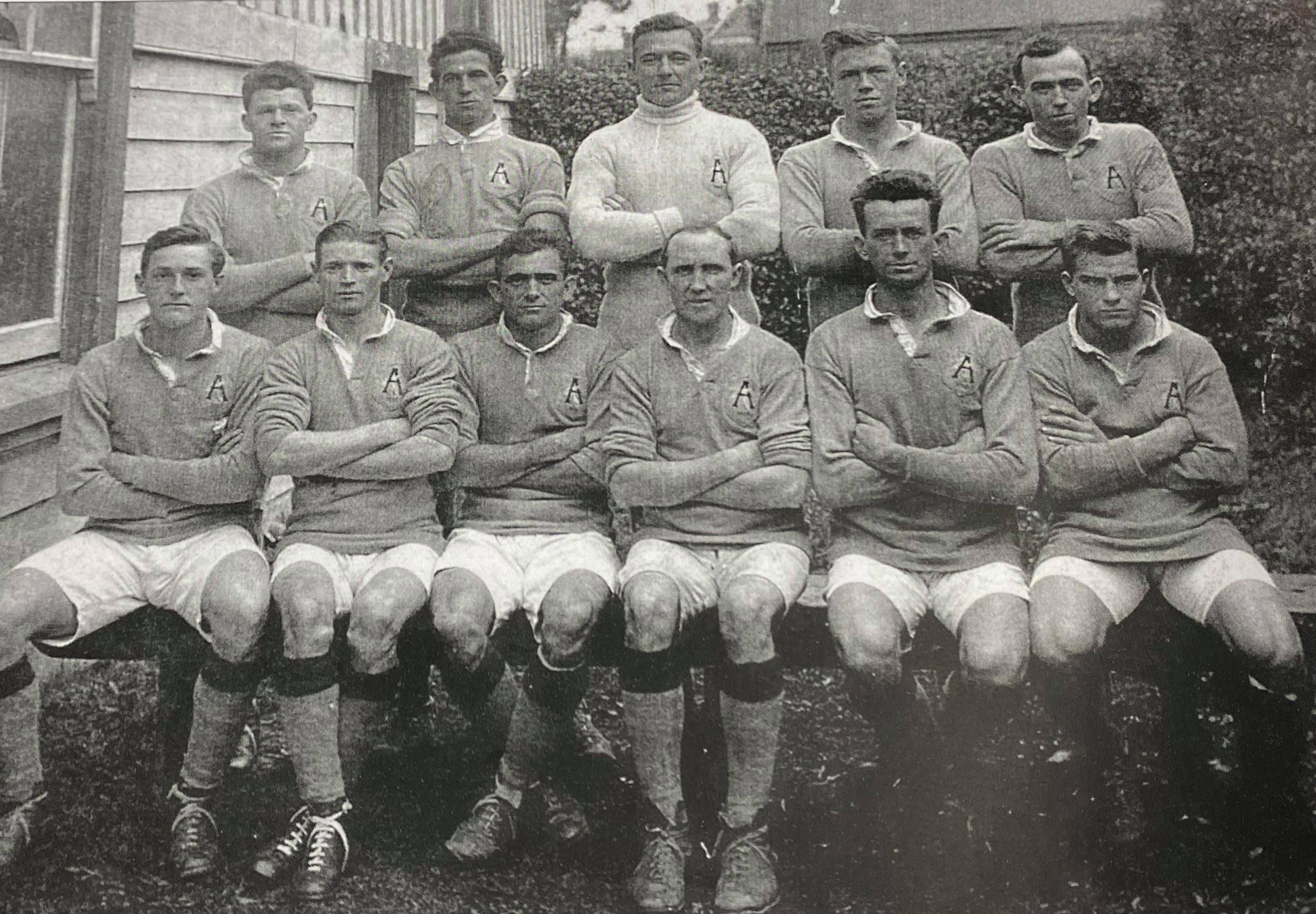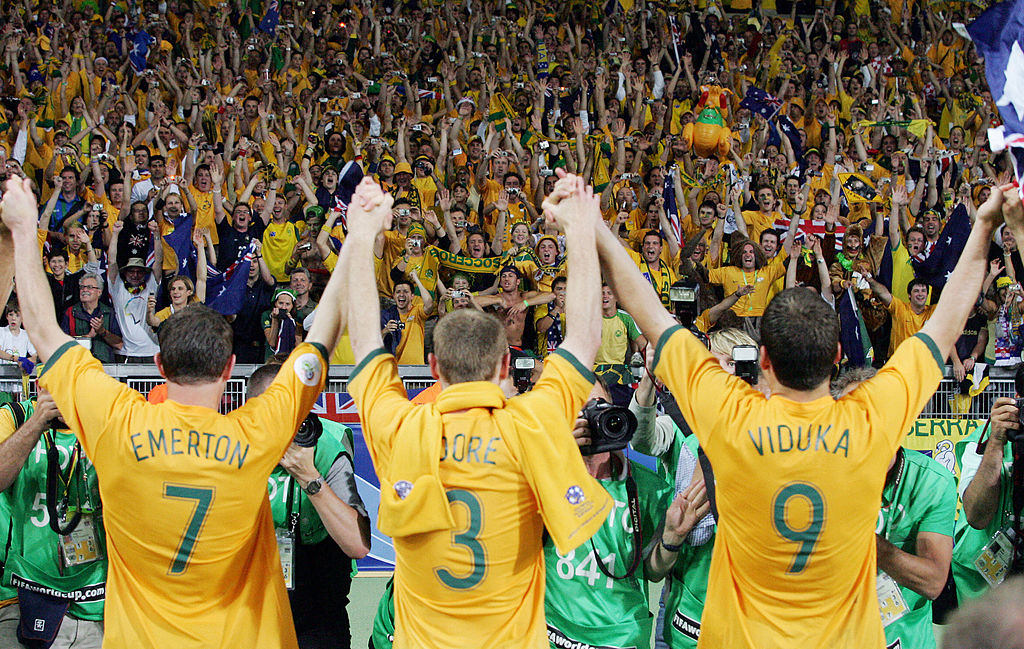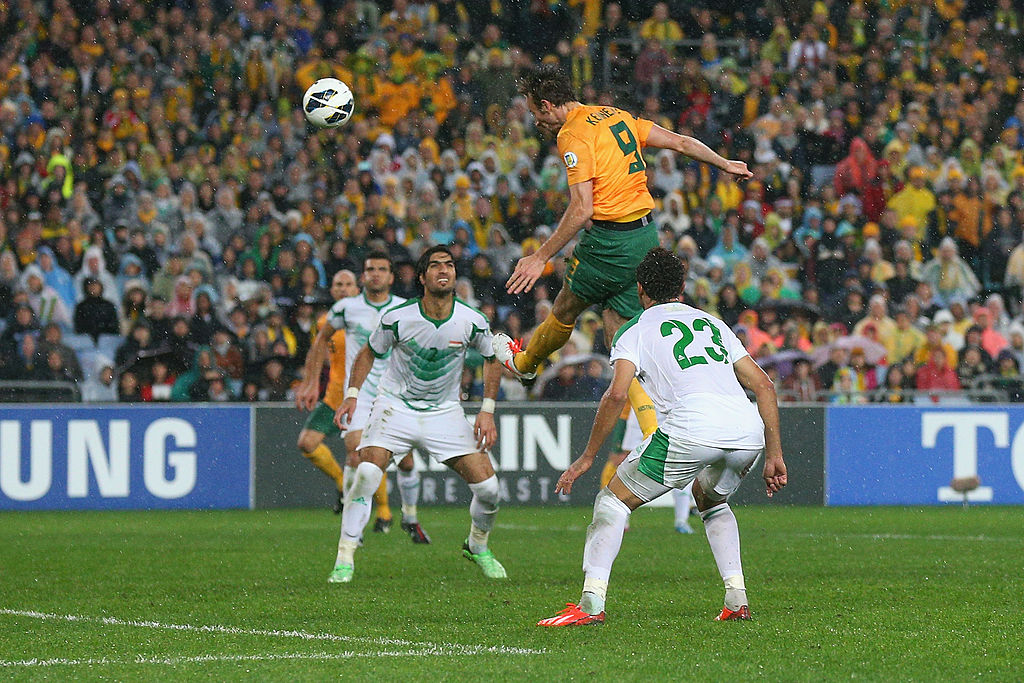The Australian Men’s National Team
The history of the Australian Men's National Football team dates all the way back to 1922, when a tour invitation from New Zealand Football was accepted by the Commonwealth Football Association.
Players from NSW and Queensland were chosen for the tour which consisted fourteen games, including three Tests. The first of those took place in Dunedin on 17 June, in which New Zealand were victorious 3-1, with William Maunder scoring the only goal for Australia.
Australia played in a light-blue strip with maroon hoops on the socks, incorporating the colours of both NSW and Queensland. They wore those colours until 1924 when Green & Gold were incorporated into the kit.

The first Australian National Men's Football Team, Dunedin NZ June 1922
Australia played their first home game in 1923, and played a range of Tests and friendlies against the likes of NZ, Canada, South Africa and India until the 1956 Olympic Games, which were the team's first 'competitive' match. Australia won their first round match against Japan 2-0, but were eliminated by India in the last eight after a 4-2 loss.
Australia's first ever FIFA World Cup qualification campaign took place in Phnom Penh against North Korea on November 21, 1965 following Australia's FIFA ban from international football from 1959-1963. It was a two-legged playoff with Australia losing the first match 6-1 and then the return leg three days later 3-1. Les Scheinflug holds the honour of scoring the first-ever goal for Australia in a World Cup qualifier with a 70th-minute penalty. North Korea would famously go on to make the quarter finals in the 1966 World Cup, losing 5-3 to Portugal.
Australia's campaign for the 1970 FIFA World Cup saw them knock out Japan, South Korea and Rhodesia. After playing three matches against Rhodesia in Mozambique, Australia travelled from the Southern African nation straight to Israel for the next stage of an arduous qualification campaign. They lost 1-0 and then returned home to only manage a 1-1 result in Sydney, which ended the World Cup dream.
But four years later under the guidance of coach Rale Rasic, Australia prevailed from the first stage of qualifying, winning a group that included New Zealand, Indonesia and Iraq. They then faced Iran home and away, winning the first leg in Sydney 3-0 before Iran won 2-0 in the second leg in Tehran. South Korea then awaited the Socceroos. Both matches ended in draws, prompting a hastily-arranged decider in Hong Kong. Jimmy Mackay scored the goal (watch it below) which booked Australia its place in the 1974 tournament.
Australia drew hosts West Germany, nearby East Germany, and South American team Chile in a difficult Group 1. The first match was against East Germany in Hamburg and Col Curran claimed an unwanted piece of history, becoming the first Australian to score in the World Cup finals - albeit for the other side. Australia lost that match 2-0 and backed up four days later against West Germany, losing 3-0. Against Chile in Berlin, Australia claimed its first World Cup point courtesy of a 0-0 draw.

The Socceroos at the 1974 FIFA World Cup
The Socceroos were unsuccessful in qualifying for 1978 but secured their first ever piece of official silverware in 1980, winning the OFC Nations Cup, which was won a further three times (1996, 2000, and 2004).
Further attempts in '82, '86, '90 and '94 were also unsuccessful, with the latter campaign coming as close as Australia had been, losing 2-1 on aggregate to a Diego Maradona-lead Argentina.
But it wasn't until the 1998 qualifying campaign, where Australia were just 15 minutes away from a first FIFA World Cup appearance in 24 years, that the ultimate heartbreak was felt. With a 2-0 lead (3-1 on aggregate) over Iran at the MCG, the Socceroos conceded twice to draw the match 2-2, with Iran qualifying for the France World Cup 3-3 on aggregate.
The next campaign ended in another disappointing end, with a 3-1 loss on aggregate against South American powerhouse Uruguay, despite holding a 1-0 lead after the first leg. But the culmination of all of the heartbreak was let go just four years later.
The Socceroos were up against Uruguay once again for a spot in the World Cup, and went into the second leg trailing 1-0 after a loss in Montevideo. Mark Bresciano managed to equalise in the first half of the return leg in Sydney, and after a pulsating 120 minutes, the game went to penalties. Mark Schwarzer proved to be the hero, saving two of Uruguay's spot-kicks, and setting up John Aloisi to convert the penalty that ended Australia's 32-year exile from the FIFA World Cup.
Back among the World Cup elite after 32 years, Australia was faced with Brazil, Japan and Croatia in its group in 2006. The fairytale continued to roll on in the group stages. Trailing 1-0 with fewer than 10 minutes left in the opening match against Japan in Kaiserslautern, it looked as if the World Cup dream would be over before it began.
But up stepped Tim Cahill, writing his place in history as the first player to score a goal for Australia at a World Cup. On 89 minutes, Cahill struck again to put Australia in front, while a stunning comeback was complete when Aloisi scored in injury time.
Brazil, the most dominant team in World Cup history and the defending World Cup champion, was next in Munich. A determined Australia was unlucky to lose 2-0, but a draw against Croatia would be enough to get through to the round of 16. The drama continued in the match in Stuttgart, with Croatia scoring in just the second minute. Craig Moore levelled things up before half-time thanks to a penalty, but a mistake from goalkeeper Zeljko Kalac allowed Croatia to take the lead again just over 30 minutes from time.
In a frantic finish, Australia peppered the Croatian goalkeeper with Harry Kewell scoring the crucial goal with just 11 minutes left. Referee Graham Poll infamously showed Croatian defender Josip Simunic three yellow cards, while he blew full time as Aloisi was about to give Australia victory, but it was all academic as the Socceroos progressed to the Round of 16.

Socceroos celebrate with the fans after the Croatia match.
Italy and even more drama awaited in Kaiserslautern. With the match delicately poised at 0-0, Marco Materazzi would be sent off on 50 minutes, giving Australia a fantastic opportunity to progress to the final eight. But fate dealt the brave Aussies a cruel hand in the final minute of normal time with Lucas Neill and Fabio Grosso coming together in the box. The referee pointed to the spot and Francesco Totti would score the penalty which broke Australia's heart. Italy would go on to win the final.
Following the tournament, the Socceroos officially moved from Oceania to the Asian Football Confederation and made their debut in Asia in August 2006 with a home match against Kuwait in a 2007 AFC Asian Cup Qualifier. The team qualified for the tournament, held in South East Asia, losing out on penalties to Japan in the Quarter Finals.
The Socceroos qualified for the 2010 FIFA World Cup in South Africa in comfortable fashion, but this time were unsuccessful in advancing from the group stage. A 4-0 defeat by Germany first up was followed by a 1-1 draw with Ghana, but a 2-1 win over Serbia in the final game was not enough to progress.
The team secured a spot at the AFC Asian Cup Final in 2011, but were once again defeated by Japan, who scored an 109th minute extra-time goal to win 1-0. Australia qualified for a third-straight FIFA World Cup ahead of the Brazil tournament in 2014, courtesy of a famous header from Josh Kennedy against Iraq.

THAT Josh Kennedy header
But this time, under the guidance of Ange Postecoglou, the Socceroos suffered three straight defeats against Chile, the Netherlands, and Spain. However, only six months later, came one of the greatest moments in Socceroos history.
Australia had won hosting rights to the 2015 AFC Asian Cup, which took place in January of that year. Australia secured wins over Kuwait and Oman in the group stage, booking a spot against China in the Quarter Finals. A double from Tim Cahill in Brisbane saw the Socceroos win 2-0 and gain momentum as the tournament went on.
The Semi Finals saw the Socceroos come up against the United Arab Emirates in Newcastle, and the side were 2-0 up inside 14 minutes thanks to Jason Davidson and Trent Sainsbury. The scored stayed that way, and Australia were into a second consecutive Final. And they wouldn't face Japan, they'd face Korea Republic.
Over 76,000 people packed into Stadium Australia, the same venue that the Socceroos had qualified for the 2006 FIFA World Cup 10 years prior, to witness another momentous evening. A Mass Luongo goal had Australia 1-0 up, before a crushing equaliser from Korea in injury-time. But Australia would prevail in extra-time, with some superb work from Tomi Juric setting up James Troisi for the winner. Australia became Champions of Asia!
.jpg)
The Socceroos celebrate after winning the AFC Asian Cup Final 2015
Postecoglou continued on as Head Coach and the Road to the 2018 FIFA World Cup in Russia was the longest of any national team, ever. The side finished third in the final group after 18 matches, and had to play-off against a fellow AFC side and then a side from CONCACAF to make it to a fourth-straight World Cup. A spirited performance against Syria over two legs saw Australia advance 3-2 on aggregate, before defeating Honduras 3-1 across a gruelling two legs.
Australia, under new coach Bert van Marwijk, were drawn against France, Denmark and Peru in Russia, and it was another difficult tournament for the team. The side came close against eventual Champions France, narrowly losing 2-1, before drawing 1-1 against Denmark. However, in a must-win clash against Peru, the Socceroos suffered a 2-0 loss.
Hoping to back up their AFC Asian Cup win in 2019 in the UAE, with Graham Arnold in charge, the Socceroos were unable to defend their crown. The side made it out of the group against Jordan, Palestine, and Syria, but fell to hosts UAE in the Quarter Finals.
In 2022, the Socceroos qualified for their fifth consecutive FIFA World Cup after defeating Peru in a penalty shootout in their playoff match. The win capped off 20 qualifiers on the way to securing their spot in Qatar.

